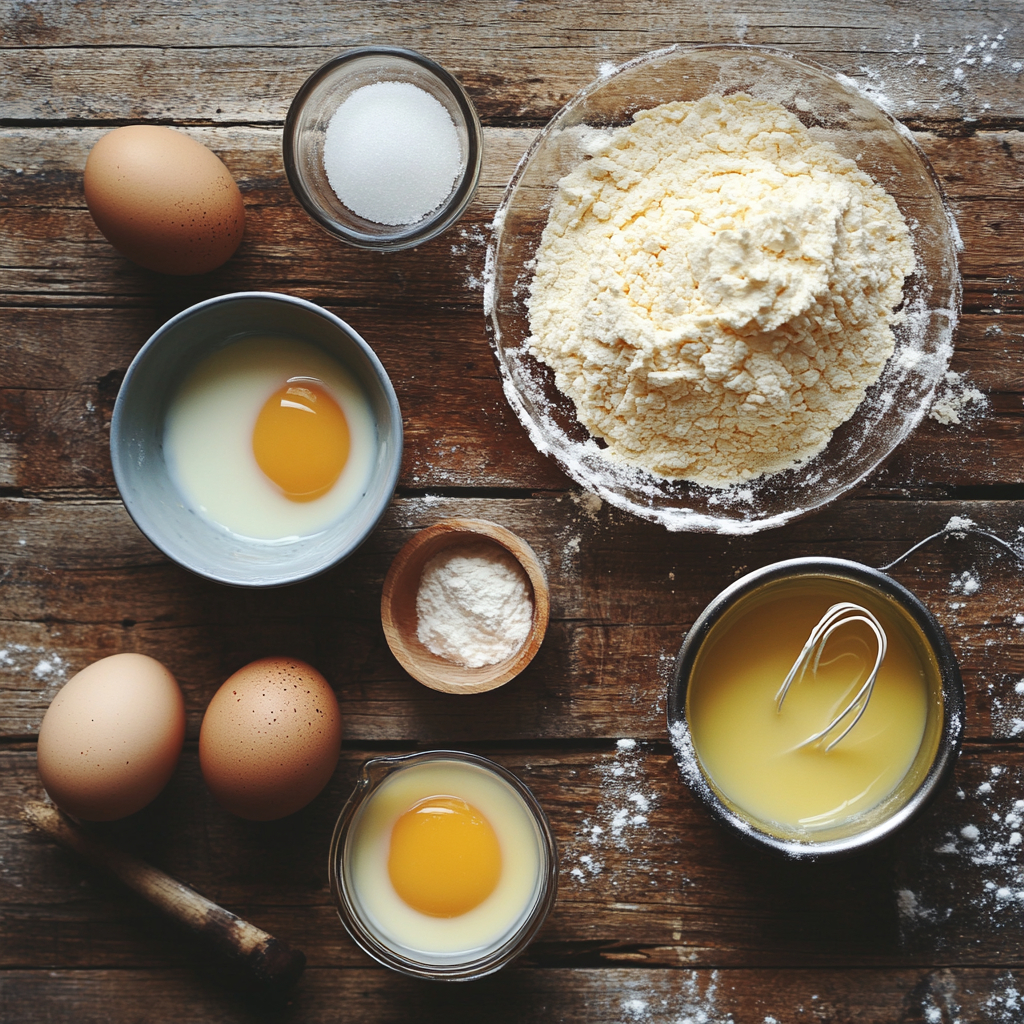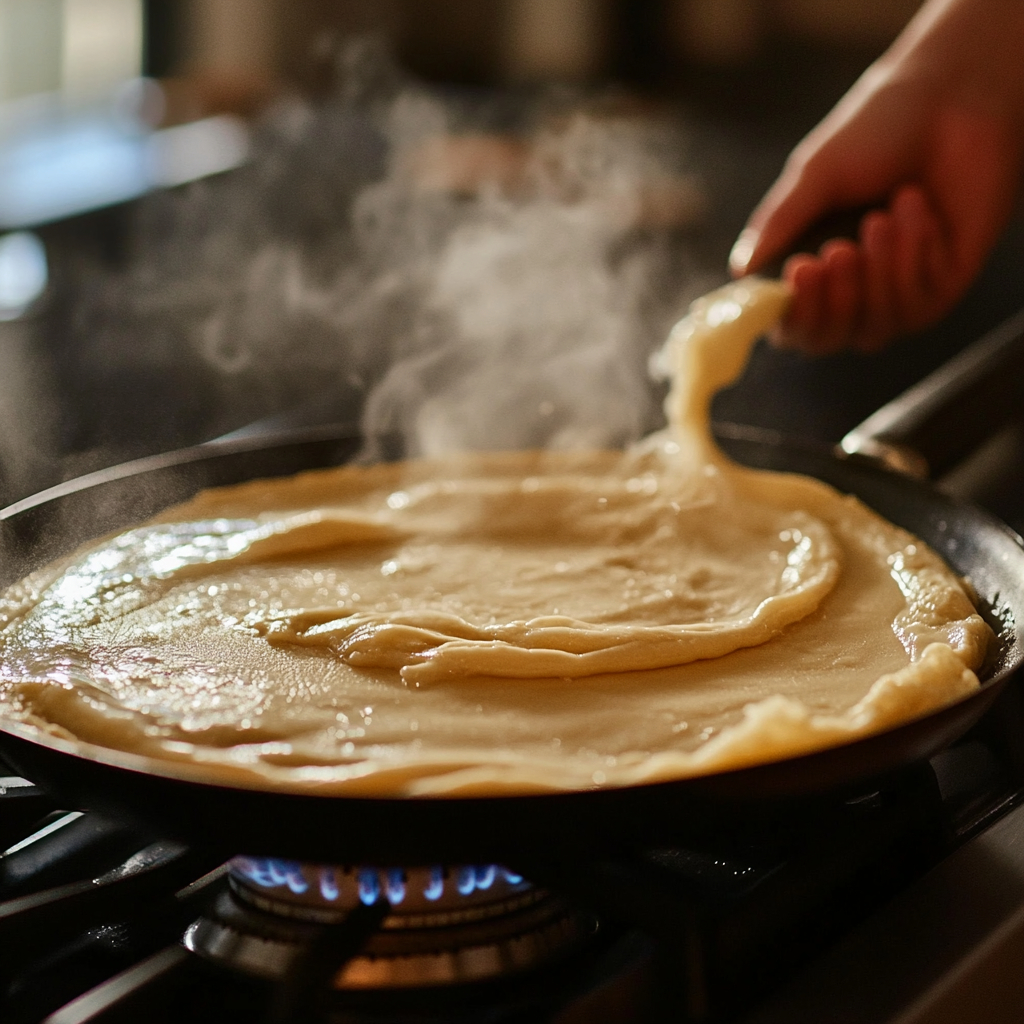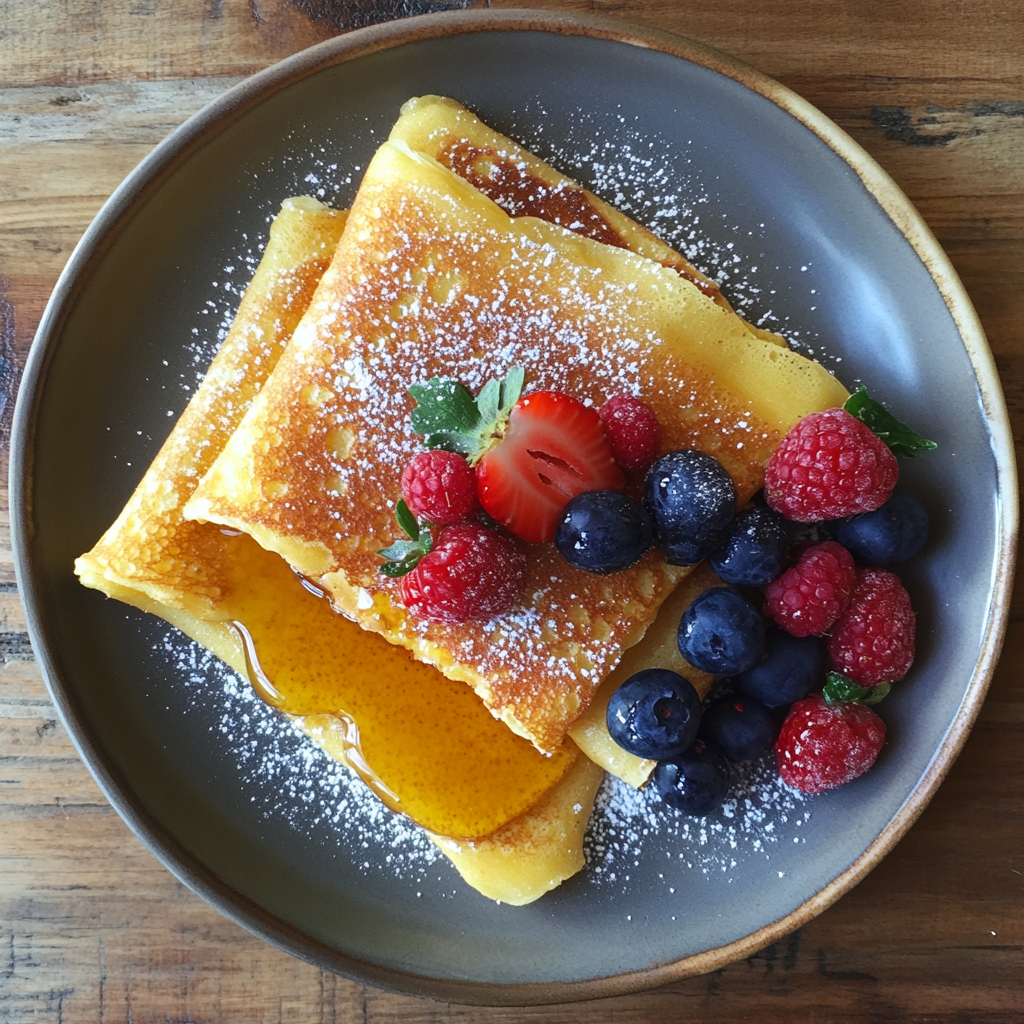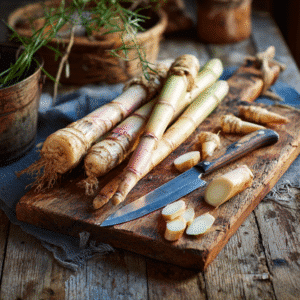Few things in the culinary world are as effortlessly elegant as French crepes. Whether folded with fresh strawberries and cream or wrapped around ham and melted cheese, these delicate pancakes are a beloved part of French cuisine—and for good reason. Paper-thin, buttery, and endlessly versatile, crepes can be enjoyed for breakfast, brunch, dessert, or dinner.
In this complete guide, we’ll show you how to master authentic French crepes from batter to pan. Whether you’re a beginner or looking to perfect your technique, this is everything you need to know—from ingredients to secret tips and classic fillings.
Don’t miss our French Stuffed Cabbage Rolls (Choux Farcis) if you love traditional French recipes with rich, comforting flavors.
Table Of Content
Table of Contents
What Are French Crepes and Why Are They Loved Worldwide?
The Origins of French Crêpes: From Brittany to the World
Crepes have been part of French culture since the 13th century, when they originated in Brittany (Bretagne), a region in northwest France. Originally made with buckwheat and cooked on flat stones, crepes became a daily staple in Breton households. Eventually, white flour replaced buckwheat for sweet crepes, while buckwheat remained the base for savory galettes.
Today, French crepes are a symbol of hospitality and indulgence. They’re served at street markets, in crêperies, and at home—especially on La Chandeleur, a national day of crepe-making celebrated every February 2nd.
What started as a simple regional dish is now a global favorite, thanks to its adaptability and irresistible texture.
Why French Crepes Remain a Timeless Favorite
Unlike pancakes or waffles, crepes are incredibly versatile and elegant. You can fold, roll, or layer them. Fill them with fruits, spreads, cheese, or meats. Enjoy them hot or cold, sweet or savory. Their lightness makes them ideal for any meal of the day.
Here’s why they stand the test of time:
- Minimal ingredients, maximum flavor
- Fast to cook and easy to prep ahead
- Endlessly customizable for different diets and preferences
- Loved by kids and adults alike
French crepes have become a staple in kitchens around the world for good reason—they’re both easy to make and incredibly satisfying to eat.
Looking for other classic French comfort recipes? Try our One Pan Chicken Orzo Recipe for a creamy, satisfying dinner.
French Crepes vs. English Pancakes – What’s the Difference?
Texture, Thickness, and Technique
At first glance, you might think French crepes and English pancakes are nearly the same—they’re both flat, round, and made from a batter of eggs, milk, and flour. But look closer (or take one bite), and the differences become clear.
French crepes are famously thin and delicate. They’re cooked quickly in a hot, lightly buttered pan and spread into a very thin layer using a swirling motion or a crepe spreader. The result is paper-thin, slightly crispy at the edges, and soft in the center.
English pancakes, by contrast, are slightly thicker and chewier. They often have more flour in the batter and aren’t spread out as thinly during cooking. The result resembles a cross between a crepe and an American-style pancake—soft, with a bit more substance.
Comparison at a glance:
| Feature | French Crepes | English Pancakes |
|---|---|---|
| Thickness | Very thin | Thicker and softer |
| Texture | Delicate, slightly crisp at edges | Spongier and fluffier |
| Usage | Sweet or savory | Mostly sweet |
| Batter Rest Time | Usually rested before cooking | Often used immediately |
| Folding Style | Folded, rolled, or stacked | Usually rolled or folded simply |
The difference in technique also plays a role. French crepes are often made in nonstick or seasoned steel pans over medium-high heat and flipped with skill. English pancakes are typically flipped once with a spatula and often enjoyed with lemon and sugar.
Sweet vs. Savory Usage and Serving Traditions
French crepes are as likely to be filled with savory ingredients as sweet. In fact, savory crepes—called galettes—are a cornerstone of Brittany cuisine, made with buckwheat flour and filled with ham, eggs, cheese, or vegetables.
Sweet crepes, on the other hand, are often enjoyed with:
- Nutella
- Butter and sugar
- Fresh berries or bananas
- Jam or preserves
- Whipped cream
English pancakes are mostly eaten sweet, especially during Shrove Tuesday (Pancake Day) in the UK, when they’re traditionally served with lemon juice and sugar.
So, while both are delicious, French crepes offer more culinary flexibility. They can start your day at breakfast or end it as dessert—or even become the main course.
Love exploring traditional dishes with depth? Don’t miss our French Stuffed Cabbage Rolls (Choux Farcis) for another iconic recipe from France’s comfort food collection.
Essential Ingredients for Authentic French Crepes

Core Crepe Batter Ingredients (Eggs, Flour, Milk)
To master French crepes, it all starts with the batter. While the recipe is surprisingly simple, precision and balance are key. Each ingredient plays an important role in achieving the perfect texture—thin, flexible, and just the right amount of chew.
Basic French Crepe Batter:
| Ingredient | Amount | Purpose |
|---|---|---|
| All-purpose flour | 1 cup (125g) | The structure of the crepe |
| Eggs | 2 large | Adds richness and binds the batter |
| Milk | 1½ cups (360ml) | Thins the batter for that classic light texture |
| Butter | 2 tbsp (melted) | For flavor and to prevent sticking |
| Salt | ¼ tsp | Enhances overall flavor |
| Optional: Sugar | 1 tbsp (for sweet crepes) | Adds mild sweetness and color |
Mixing these ingredients together until smooth creates a thin, pourable batter ideal for swirling in a hot pan. Most classic French cooks recommend letting the batter rest for at least 30 minutes to allow the flour to fully hydrate and prevent rubbery results.
If you’re looking for a great base crepe recipe, this simple combination is foolproof—just be sure to follow the resting rule.
Optional Add-ins for Flavor, Texture, and Versatility
Once you’ve mastered the classic French crepes recipe, you can begin experimenting with optional ingredients to suit the occasion—whether sweet or savory.
Popular add-ins and variations:
- Vanilla extract – Enhances sweet crepes and pairs well with fruit or whipped cream.
- Orange zest or liqueur (like Grand Marnier) – For Crêpes Suzette or a more refined dessert touch.
- Buckwheat flour – Used for savory crepes (galettes), especially in Brittany.
- Herbs (like chives or parsley) – Great for adding flavor to savory batter.
- Almond flour or oat flour – For gluten-sensitive variations.
For a savory twist, simply skip the sugar and consider reducing the butter. Adding a touch of pepper or grated cheese into the batter can add even more depth.
The versatility of French crepes is one of the reasons they remain a favorite around the world. Whether you’re serving them for breakfast, lunch, or dessert, you can tailor the batter to match your menu.
Looking for another easy, elegant French recipe? Try our One-Pan Marry Me Chicken Orzo—creamy, flavorful, and weeknight-friendly.
Step-by-Step – How to Make Proper French Crêpes

Mixing the Batter: Tools, Timing, and Resting
Making French crepes at home may seem intimidating, but with the right method and a little patience, it’s easier than you think. The process starts with preparing a smooth, lump-free batter that rests to develop the perfect texture.
Step-by-step batter prep:
- Gather your tools:
- Mixing bowl
- Whisk or blender
- Measuring cups/spoons
- Fine mesh sieve (optional but helpful for smoothness)
- Sift the flour into a large bowl to remove clumps.
- Add eggs and whisk gently to combine with the flour.
- Gradually pour in milk, whisking continuously to avoid lumps. Add melted butter and a pinch of salt (and sugar if making sweet crepes).
- Strain the batter through a sieve if necessary for an ultra-smooth finish.
- Let it rest for 30 minutes to 1 hour. This allows the gluten to relax and prevents rubbery or tough crepes.
Tip: You can also make the batter the night before and refrigerate it, covered. Just give it a quick stir before using.
Cooking and Flipping Crêpes Like a French Chef
Once your batter is ready, it’s time to cook your French crepes. The goal is a thin, evenly cooked crepe with lightly golden edges and a soft center.
Here’s how to do it:
- Heat a nonstick or crepe pan over medium heat. Add a small dab of butter or oil and swirl to coat.
- Pour the batter (about ¼ cup for an 8–10” pan) into the center of the pan and quickly tilt and swirl to spread it thinly across the surface.
- Cook for 45–60 seconds, or until the edges lift slightly and the underside is lightly golden.
- Flip with a spatula or your fingers if you’re feeling bold. Cook another 30–40 seconds on the second side.
- Stack on a plate lined with a clean towel to keep warm as you cook the rest.
Repeat until all the batter is used. This method creates thin, flexible French crepes that can be filled, folded, or rolled any way you like.
Looking for more one-skillet meals that deliver big on taste? Don’t miss our Easy Chicken Cheesesteak Skillet, another quick and satisfying dish made with minimal effort.
The Secret to Perfect Crepes Every Time
Temperature Control and Pan Type
Making French crepes is as much about technique as it is about ingredients. Even with a flawless batter, your crepes can stick, tear, or cook unevenly without the right tools and temperature.
The perfect pan:
- Use a nonstick skillet or a traditional crepe pan with low sides for easy flipping.
- Cast iron works well if it’s well-seasoned and preheated correctly.
- For thin, evenly cooked crepes, a pan between 8 and 10 inches in diameter is ideal.
Heat matters:
- Preheat your pan fully before pouring the batter. It should be hot enough that a drop of water sizzles instantly.
- Keep the heat at medium to medium-high for even browning without burning.
- If your first crepe comes out too thick or pale, adjust the heat slightly and try again.
Butter vs. oil:
- Butter adds rich flavor but burns quickly—wipe the pan after each use or switch to clarified butter.
- Neutral oils like grapeseed or canola are safer for higher heat and work well too.
Common Mistakes to Avoid and Expert Fixes
Even seasoned home cooks can run into issues with crepes. Luckily, most problems are easy to fix with a little knowledge.
Mistake 1: Batter is too thick
- A thick batter won’t spread properly. Solution: Add a splash of milk and whisk again.
Mistake 2: Crepes tear while flipping
- They likely need more time on the first side. Let the edges lift before flipping gently.
Mistake 3: Lumpy batter
- This usually happens when adding milk too quickly to flour. Use a blender or strain the batter for a smoother texture.
Mistake 4: Uneven color or overcooked spots
- Keep your pan at a steady temperature and swirl the batter quickly for even coating.
Mistake 5: Rubber-like crepes
- This is often due to over-mixing or skipping the resting time. Always rest your batter for at least 30 minutes.
Once you learn the rhythm—pour, swirl, cook, flip—you’ll be turning out flawless French crepes in no time.
Love foolproof cooking tips? Try our One-Pan Chicken Orzo Recipe for another simple meal that gets rave reviews every time.
Sweet Crepe Fillings French People Love

Traditional Combos: Nutella, Sugar-Butter, Lemon
When it comes to sweet French crepes, simplicity often wins. In France, you’ll find that many locals prefer minimalist fillings that let the buttery flavor and delicate texture of the crepe shine. From street vendors in Paris to homemade Sunday brunches, these are the classics you’ll see again and again.
Popular traditional sweet crepe fillings:
- Sugar and butter – Melted butter sprinkled with white or brown sugar, sometimes topped with cinnamon.
- Fresh lemon juice and sugar – A bright, tangy twist that balances the richness of the batter.
- Nutella – The modern French favorite. Rich, creamy, and always satisfying.
- Apricot, raspberry, or strawberry jam – Light, fruity, and delicious with a dollop of cream or butter.
These fillings are often folded into quarters or rolled into cigar shapes for easy eating, especially from a crêpe stand or café.
Fresh Fruit, Whipped Cream, and Seasonal Favorites
While classic fillings never go out of style, French cuisine also celebrates the seasons. Many homes and cafés adapt their French crepes to reflect fresh, local produce and festive flavors.
Sweet crepe filling ideas to try:
- Sautéed apples with cinnamon and honey
- Bananas with caramel sauce or chocolate drizzle
- Crème Chantilly (lightly sweetened whipped cream) and berries
- Melted chocolate and roasted hazelnuts
- Poached pears with almond cream or frangipane
For special occasions, crepes can also be flambéed with orange liqueur to create Crêpes Suzette, a decadent citrusy dessert that originated in the early 1900s.
What’s great about sweet French crepes is how effortlessly they adapt—whether you want a light treat or a showstopping dessert. The key is to keep the filling balanced and not overwhelm the crepe itself.
Looking for another French dish that celebrates bold yet simple flavors? Try our French Stuffed Cabbage Rolls (Choux Farcis) for a savory counterpart to your sweet creations.
Savory French Crepes (Galettes) You Need to Try
Popular Fillings: Ham & Cheese, Mushrooms, Egg
While sweet crepes get a lot of love, savory French crepes—called galettes—are just as iconic. Originating in Brittany, these are typically made from buckwheat flour, giving them a nutty flavor and crispier texture than their sweet, white-flour counterparts.
Galettes are often served as a main course, especially during lunch or dinner. Their savory fillings are warm, hearty, and endlessly customizable.
Traditional galette fillings in France include:
- Jambon Fromage (ham and cheese) – A café classic, often made with Gruyère or Emmental.
- Complète – Ham, cheese, and egg, with the egg cooked right in the center of the open crepe.
- Mushrooms with garlic and herbs – Often paired with crème fraîche for added richness.
- Spinach and goat cheese – A light yet flavorful vegetarian option.
- Smoked salmon and crème fraîche – Perfect for a brunch-style crepe.
Savory French crepes can be folded into squares to hold the filling open-faced or rolled for a neater presentation.
Buckwheat vs. White Flour: The Base for Savory Perfection
The biggest difference between sweet and savory crepes lies in the flour. While standard French crepes are made with white flour, galettes rely on buckwheat flour (farine de sarrasin), which is gluten-free by nature and has a hearty, rustic taste.
Buckwheat Crepe Batter (Galette de Sarrasin):
| Ingredient | Amount |
|---|---|
| Buckwheat flour | 1 cup |
| Water | 1½ cups |
| Egg | 1 |
| Salt | ¼ tsp |
This batter is even simpler than sweet crepes. It’s often made without milk or butter and rested longer (up to 2 hours) to hydrate the buckwheat and ensure a smooth, pourable texture.
Buckwheat galettes are not only rich in flavor—they’re also a healthy, high-fiber option, making them a fantastic base for nutrient-dense meals.
Explore more hearty, savory comfort food by trying our Easy Chicken Cheesesteak Skillet, a skillet favorite packed with flavor.
What to Serve with French Crepes
Breakfast, Dessert, or Dinner: How to Build a Full Meal
One of the best things about French crepes is how easily they fit into any meal of the day. Whether you’re making a quick weekday breakfast, hosting a weekend brunch, or preparing a cozy dinner, crepes can be the star of the plate or part of a larger spread.
For breakfast or brunch:
- Fruit salad – Adds color, sweetness, and freshness to the plate
- Greek yogurt or crème fraîche – Pairs well with berries, jam, or honey-filled crepes
- Bacon or sausage – Savory sides to balance sweeter fillings
- Soft scrambled eggs – Great with a galette or as a filling in a buckwheat crepe
For dessert:
- Vanilla ice cream – Melts beautifully over warm crepes with chocolate or caramel
- Espresso or coffee – A classic French pairing for crepes with sugar or Nutella
- Whipped cream and berries – A simple, elegant topper that always works
For dinner (with savory crepes):
- Light salad – Try arugula or mesclun with vinaigrette for contrast
- French onion soup – Rich and cheesy, great as a starter with a crepe entrée
- Roasted vegetables – Carrots, squash, or leeks add seasonal flair
- Sautéed mushrooms – Excellent alongside a cheese or egg galette
These options turn your French crepes into a full, balanced meal that works for any occasion.
Drinks and Pairings: Coffee, Cider, or Champagne?
Traditional drink pairings can elevate your crepe experience—especially if you’re trying to recreate the feeling of a French café or crêperie at home.
Best drink pairings for crepes:
| Crepe Type | Drink Pairing |
|---|---|
| Sweet crepes | Coffee, tea, hot chocolate |
| Nutella or fruit crepes | Sparkling water or rosé |
| Savory galettes | French cider (cidre brut) |
| Dessert crepes | Champagne or dessert wine |
In Brittany, dry apple cider is the traditional beverage served with savory buckwheat galettes. Its slight acidity and carbonation balance the richness of the fillings perfectly.
Want a sweet and savory combo that satisfies like no other? Try our Healthier Cheesy Hashbrown Casserole alongside crepes for the ultimate brunch pairing.
How to Store and Reheat French Crepes Without Drying Them Out
Short-Term vs. Freezer Storage Options
Whether you’re prepping ahead or dealing with leftovers, French crepes store well and can be reheated without losing their soft texture—if done right. Since they’re thin and delicate, proper wrapping and handling is key to keeping them fresh.
Refrigerator storage (1–2 days):
- Let the crepes cool completely before storing.
- Stack them with parchment paper or wax paper in between each layer.
- Place in a sealed container or zip-top bag and refrigerate.
Freezer storage (up to 2 months):
- Stack crepes with parchment paper between each one.
- Wrap the whole stack tightly in plastic wrap, then place in a freezer bag or airtight container.
- Label with the date and freeze flat.
Frozen French crepes thaw quickly and can be used just like fresh—perfect for busy mornings or last-minute dessert ideas.
Reheating Techniques for Soft, Fresh-Tasting Results
To keep your French crepes soft and pliable (not rubbery or dried out), gentle reheating is essential.
Best reheating methods:
- Microwave (for speed): Place a damp paper towel over one or two crepes and heat for 10–15 seconds.
- Stovetop (best for texture): Heat a nonstick skillet over low-medium heat. Warm each crepe for about 30 seconds per side.
- Oven (for large batches): Preheat to 300°F (150°C). Stack crepes with parchment in between, wrap in foil, and warm for 10–15 minutes.
Avoid high heat or reheating for too long—this can make crepes tough and dry.
Once warmed, fill and serve immediately. Whether sweet or savory, French crepes reheat beautifully when handled with care.
Want more meal ideas that store and reheat well? Check out our French Stuffed Cabbage Rolls (Choux Farcis), another make-ahead classic from French kitchens.
FAQs About French Crepes
What is the difference between French and English crepes?
The main difference lies in thickness and texture. French crepes are thin, delicate, and flexible, often made with a batter that rests to improve smoothness. English crepes, sometimes called pancakes in the UK, are thicker, chewier, and typically served with sweet toppings like lemon and sugar. French crepes are also more versatile, used in both sweet and savory recipes like galettes.
What do French people eat crepes with?
In France, crepes are eaten with a wide variety of fillings depending on the time of day and region. Sweet French crepes are often topped with Nutella, fruit jam, sugar and lemon, or chestnut spread. Savory crepes, especially galettes made from buckwheat, are commonly filled with ham, cheese, eggs, or sautéed mushrooms. Crepes are enjoyed at breakfast, dessert, or dinner, and are especially popular during holidays like La Chandeleur.
How to make proper French crêpes?
To make authentic French crepes, you’ll need a simple batter of flour, eggs, milk, melted butter, and a pinch of salt (with optional sugar for sweet versions). The batter should be whisked until smooth and rested for at least 30 minutes. Use a nonstick or crepe pan, pour in a small amount of batter, swirl to coat, and cook each side until lightly golden. Proper French crepes should be thin, flexible, and cooked evenly.
What is the secret to perfect crepes?
The secret lies in resting the batter, using a properly heated nonstick pan, and controlling the pour. A rested batter yields smoother, more elastic crepes, while a hot pan helps achieve a lightly golden surface without sticking. Thin batter and quick swirling ensure even coverage, while minimal flipping helps maintain their soft texture. These small steps are what give French crepes their signature lightness and flavor.
Conclusion: Why French Crepes Belong in Your Recipe Rotation
Elegant, easy, and endlessly adaptable, French crepes are the perfect canvas for sweet and savory creations. Whether you’re starting your day with a jam-filled crepe or serving up a rustic galette for dinner, these thin pancakes offer a taste of classic French tradition in every bite.
You don’t need fancy tools or professional training to make them—just a simple batter, a hot pan, and a bit of patience. From family brunches to romantic desserts, French crepes bring versatility and joy to the table year-round.
For more comfort classics that never fail to impress, check out our French Stuffed Cabbage Rolls (Choux Farcis) and Healthier Cheesy Hashbrown Casserole—ideal additions to your homemade favorites.
Print
French Crepes: The Ultimate Guide to Making Light, Delicious Crêpes Like a Pro
- Total Time: 30 minutes
- Yield: 12 crepes 1x
- Diet: Vegetarian
Description
French Crepes are thin, delicate pancakes that are endlessly versatile. Whether filled with Nutella, fresh fruit, or savory ingredients like ham and cheese, these elegant crepes are a classic staple of French cuisine, perfect for breakfast, brunch, dessert, or dinner.
Ingredients
- 1 cup (125g) all-purpose flour
- 2 large eggs
- 1½ cups (360ml) milk
- 2 tbsp melted butter
- ¼ tsp salt
- 1 tbsp sugar (optional, for sweet crepes)
- 1 tsp vanilla extract (optional, for sweet crepes)
- Butter or oil, for greasing the pan
Instructions
- In a mixing bowl, whisk together flour, eggs, and half of the milk until smooth. Gradually add the remaining milk, melted butter, salt, and sugar (if using). Optional: stir in vanilla for sweet crepes.
- Let the batter rest for at least 30 minutes at room temperature or cover and refrigerate overnight.
- Heat a nonstick or crepe pan over medium heat. Lightly grease with butter or oil.
- Pour about ¼ cup of batter into the pan and swirl immediately to spread it thinly across the surface.
- Cook for 45–60 seconds until the edges lift and the bottom is lightly golden. Flip and cook the second side for 30–40 seconds.
- Transfer to a plate and cover to keep warm. Repeat with remaining batter, greasing the pan as needed.
- Fill with desired toppings—sweet or savory—and serve warm or at room temperature.
Notes
Crepes can be made ahead and stored in the fridge for 2 days or frozen for up to 2 months. Stack with parchment paper between each one. For savory crepes (galettes), replace some or all of the all-purpose flour with buckwheat flour and omit the sugar and vanilla.
- Prep Time: 10 minutes
- Cook Time: 20 minutes
- Category: Breakfast, Brunch, Dessert
- Method: Stovetop
- Cuisine: French
Nutrition
- Serving Size: 1 crepe
- Calories: 95
- Sugar: 2g
- Sodium: 85mg
- Fat: 4g
- Saturated Fat: 2g
- Unsaturated Fat: 1g
- Trans Fat: 0g
- Carbohydrates: 11g
- Fiber: 0g
- Protein: 3g
- Cholesterol: 45mg
Keywords: french crepes, classic crepes, sweet crepes, savory crepes, breakfast crepes, easy french recipe



